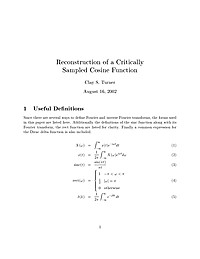Code Acquisition using Smart Antennas with Adaptive Filtering Scheme for DS-CDMA Systems
Pseudo-noise (PN) code synchronizer is an essential element of direct-sequence code division multiple access (DS-CDMA) system because data transmission is possible only after the receiver accurately synchronizes the locally generated PN code with the incoming PN code. The code synchronization is processed in two steps, acquisition and tracking, to estimate the delay offset between the two codes. Recently, the adaptive LMS filtering scheme has been proposed for performing both code acquisition and tracking with the identical structure, where the LMS algorithm is used to adjust the FIR filter taps to search for the value of delay-offset adaptively. A decision device is employed in the adaptive LMS filtering scheme as a decision variable to indicate code synchronization, hence it plays an important role for the performance of mean acquisition time (MAT). In this thesis, only code acquisition is considered. In this thesis, a new decision device, referred to as the weight vector square norm (WVSN) test method, is devised associated with the adaptive LMS filtering scheme for code acquisition in DS-CDMA system. The system probabilities of the proposed scheme are derived for evaluating MAT. Numerical analyses and simulation results verify that the performance of the proposed scheme, in terms of detection probability and MAT, is superior to the conventional scheme with mean-squared error (MSE) test method, especially when the signal-to-interference-plus-noise ratio (SINR) is relatively low. Furthermore, an efficient and joint-adaptation code acquisition scheme, i.e., a smart antenna coupled with the proposed adaptive LMS filtering scheme with the WVSN test method, is devised for applying to a base station, where all antenna elements are employed during PN code acquisition. This new scheme is a process of PN code acquisition and the weight coefficients of smart antenna jointly and adaptively. Numerical analyses and simulation results demonstrate that the performance of the proposed scheme with five antenna elements, in terms of the output SINR, the detection probability and the MAT, can be improved by around 7 dB, compared to the one with single antenna case.
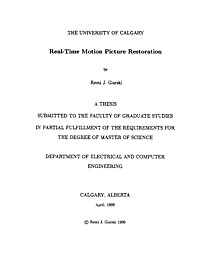
Real-time Motion Picture Restoration
Through age or misuse, motion picture films can develop damage in the form of dirt or scratches which detract from the quality of the film. Removal of these artifacts is a worthwhile process as it makes the films more visually attractive and extends the life of the material. In this thesis, various methods for detecting and concealing the effects of film damage are described. Appropriate algorithms are selected for implementation of a system, based on a TMS320C80 video processor, which can remove the effects of film defects using digital processing. The restoration process operates in real-time at video frame rates (30 frames per second). Details of the software implementation of this system are presented along with results from processing damaged film material. The effects of damage are significantly reduced after processing.
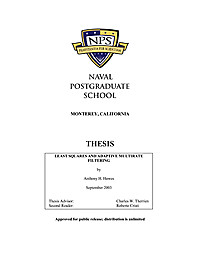
Least Squares and Adaptive Multirate Filtering
This thesis addresses the problem of estimating a random process from two observed signals sampled at different rates. The case where the low–rate observation has a higher signal–to– noise ratio than the high–rate observation is addressed. Both adaptive and non–adaptive filtering techniques are explored. For the non–adaptive case, a multirate version of the Wiener–Hopf optimal filter is used for estimation. Three forms of the filter are described. It is shown that using both observations with this filter achieves a lower mean–squared error than using either sequence alone. Furthermore, the amount of training data to solve for the filter weights is comparable to that needed when using either sequence alone. For the adaptive case, a multirate version of the LMS adaptive algorithm is developed. Both narrowband and broadband interference are removed using the algorithm in an adaptive noise cancellation scheme. The ability to remove interference at the high rate using observations taken at the low rate without the high–rate observations is demonstrated.

A DSP-Based Computational Engine For a Brain-Machine Interface
The fields of neurobiology and electrical engineering have come together to pursue an integrated Brain-Machine Interface (BMI). Signal processing methods are used to find mapping algorithms between motor cortex neural firing rate and hand position. This cognitive extension could help patients with quadriplegia regain some independence using a thought-controlled robot arm. Current signal processing methods to achieve realtime neural-to-motor translation involve large, multi-processor systems to produce motor control parameters. Eventually, software running in a portable signal processing system is needed to allow for the patient to have the BMI in a backpack or attached to a wheelchair. This thesis presents a DSP-Based Computational Engine for a Brain-Machine Interface. The development of a DSP Board based on the Texas Instruments TMS320VC33 DSP will be presented, along with implementations of two digital filters and their training methods: 1) FIR trained with Normalized Least Mean Square Adaptive Filter (NLMS) and 2) Recurrent Multi-Layer Perceptron (RMLP) trained with Real-Time Recurrent Learning (RTRL). The requirements of the DSP Board, component selection and integration, and control software are discussed. The DSP implementations of the digital filters are presented, along with performance and timing analysis in real data collected from an Owl Monkey at Duke University. The weights of the FIR-NLMS filter converged similarly on the DSP as they did in MATLAB. Likewise, the weights of the RMLP-RTRL filter converged similarly on the DSP as they did using the Backpropagation Through Time method in NeuroSolutions. The custom DSP Board and two digital algorithms implemented in this thesis create a starting point for an integrated, portable, real-time signal processing solution for a Brain-Machine Interface.

Fixed-Point Arithmetic: An Introduction
This document presents definitions of signed and unsigned fixed-point binary number representations and develops basic rules and guidelines for the manipulation of these number representations using the common arithmetic and logical operations found in fixed-point DSPs and hardware components.
Energy Profiling of DSP Applications, A Case Study of an Intelligent ECG Monitor
Proper balance of power and performance for optimum system organization requires precise profiling of the power consumption of different hardware subsystems as well as software functions. Moreover, power consumption of mobile systems is even more important, since the battery is a large portion of the overall size and weight of the system. Average power consumption is only a crude estimate of power requirements and battery life; a much better estimate can be made using dynamic power consumption. Dynamic power consumption is a function of the execution profile of the given application running on specific hardware platform. In this paper we introduce a new environment for energy profiling of DSP applications. The environment consists of a JTAG emulator, a high-resolution HP 3583A multimeter and a workstation that controls devices and stores the traces. We use Texas Instruments’ Real Time Data Exchange mechanism (RTDXÔ) to generate an execution profile and custom procedures for energy profile data acquisition using GPIB interface. We developed custom procedures to correlate and analyze both energy and execution profiles. The environment allows us to improve the system power consumption through changes in software organization and to measure real battery life for the given hardware, software and battery configuration. As a case study, we present the analysis of a real-time portable ECG monitor implemented using a Texas Instruments TMS320C5410-100 processor board, and a Del Mar PWA ECG Amplifier.
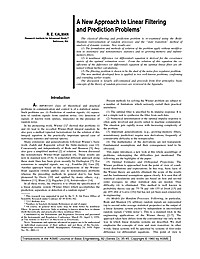
A New Approach to Linear Filtering and Prediction Problems
In 1960, R.E. Kalman published his famous paper describing a recursive solution to the discrete-data linear filtering problem. Since that time, due in large part to advances in digital computing, the Kalman filter has been the subject of extensive research and application, particularly in the area of autonomous or assisted navigation.
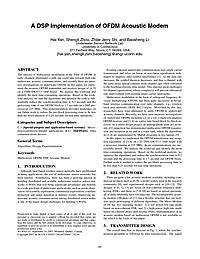
A DSP Implementation of OFDM Acoustic Modem
The success of multicarrier modulation in the form of OFDM in radio channels illuminates a path one could take towards high-rate underwater acoustic communications, and recently there are intensive investigations on underwater OFDM. In this paper, we implement the acoustic OFDM transmitter and receiver design of [4, 5] on a TMS320C6713 DSP board. We analyze the workload and identify the most time-consuming operations. Based on the workload analysis, we tune the algorithms and optimize the code to substantially reduce the synchronization time to 0.2 seconds and the processing time of one OFDM block to 1.7 seconds on a DSP processor at 225 MHz. This experimentation provides guidelines on our future work to reduce the per-block processing time to be less than the block duration of 0.23 seconds for real time operations.
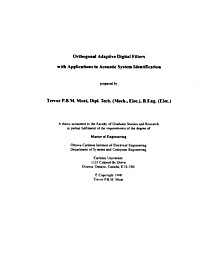
Orthogonal Adaptive Digital Filters with Applications to Acoustic System Identification
The Transform-Domain LMS Algorithm (Narayan, 1983) is studied in the context of an acoustic system identification problem. The power estimator in this two-stage digital filter is shown to affect the achievable rates and depths of convergence significantly. Preferred values for the two tracking parameters, $\beta$ and $\mu,$ are determined. Dynamic Step-size Initialization is proposed to improve early convergence by accelerating the rate at which true power measurements replace (arbitrary) initial values. Later, linear estimators are shown to be sub-optimal, particularly where the spectral distribution of the reference changes rapidly. A simple non-linear Peak Window Power Estimator which eliminates these problems is described. It will be shown to improve the tracking rates and misadjustment simultaneously. The benefits of these methods are demonstrated using FIR sequences representative of typical acoustic environments and using recordings from a commercial telephone set. The proposed structures surpass theexisting algorithms consistently under all circumstances tested.
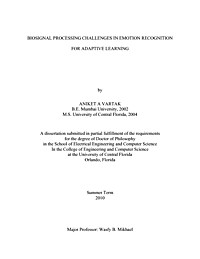
Biosignal processing challenges in emotion recognition for adaptive learning
User-centered computer based learning is an emerging field of interdisciplinary research. Research in diverse areas such as psychology, computer science, neuroscience and signal processing is making contributions to take this field to the next level. Learning systems built using contributions from these fields could be used in actual training and education instead of just laboratory proof-of-concept. One of the important advances in this research is the detection and assessment of the cognitive and emotional state of the learner using such systems. This capability moves development beyond the use of traditional user performance metrics to include system intelligence measures that are based on current theories in neuroscience. These advances are of paramount importance in the success and wide spread use of learning systems that are automated and intelligent. Emotion is considered an important aspect of how learning occurs, and yet estimating it and making adaptive adjustments are not part of most learning systems. In this research we focus on one specific aspect of constructing an adaptive and intelligent learning system, that is, estimation of the emotion of the learner as he/she is using the automated training system. The challenge starts with the definition of the emotion and the utility of it in human life. The next challenge is to measure the co-varying factors of the emotions in a non-invasive way, and find consistent features from these measures that are valid across wide population. In this research we use four physiological sensors that are non-invasive, and establish a methodology of utilizing the data from these sensors using different signal processing tools. A validated set of visual stimuli used worldwide in the research of emotion and attention, called International Affective Picture System (IAPS), is used. A dataset is collected from the sensors in an experiment designed to elicit emotions from these validated visual stimuli. We describe a novel wavelet method to calculate hemispheric asymmetry metric using electroencephalography data. This method is tested against typically used power spectral density method. We show overall improvement in accuracy in classifying specific emotions using the novel method. We also show distinctions between different discrete emotions from the autonomic nervous system activity using electrocardiography, electrodermal activity and pupil diameter changes. Findings from different features from these sensors are used to give guidelines to use each of the individual sensors in the adaptive learning environment.
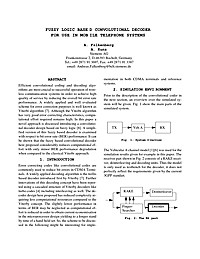
FUZZY LOGIC BASED CONVOLUTIONAL DECODER FOR USE IN MOBILE TELEPHONE SYSTEMS
Efficient convolutional coding and decoding algorithms are most crucial to successful operation of wireless communication systems in order to achieve high quality of service by reducing the overall bit error rate performance. A widely applied and well evaluated scheme for error correction purposes is well known as Viterbi algorithm [7]. Although the Viterbi algorithm has very good error correcting characteristics, computational effort required remains high. In this paper a novel approach is discussed introducing a convolutional decoder design based on fuzzy logic. A simplified version of this fuzzy based decoder is examined with respect to bit error rate (BER) performance. It can be shown that the fuzzy based convolutional decoder here proposed considerably reduces computational effort with only minor BER performance degradation when compared to the classical Viterbi approach.
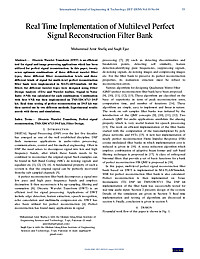
Real Time Implementation of Multi-Level Perfect Signal Reconstruction Filter Bank
Discrete Wavelet Transform (DWT) is an efficient tool for signal and image processing applications which has been utilized for perfect signal reconstruction. In this paper, twenty seven optimum combinations of three different wavelet filter types, three different filter reconstruction levels and three different kinds of signal for multi-level perfect reconstruction filter bank were implemented in MATLAB/Simulink. All the filters for different wavelet types were designed using Filter Design Analysis (FDA) and Wavelet toolbox. Signal to Noise Ratio (SNR) was calculated for each combination. Combination with best SNR was then implemented on TMS320C6713 DSP kit. Real time testing of perfect reconstruction on DSP kit was then carried out by two different methods. Experimental results accede with theory and simulations.
Optimization of Synthesis Oversampled Complex Filter Banks
An important issue with oversampled FIR analysis filter banks (FBs) is to determine inverse synthesis FBs, when they exist. Given any complex oversampled FIR analysis FB, we first provide an algorithm to determine whether there exists an inverse FIR synthesis system. We also provide a method to ensure the Hermitian symmetry property on the synthesis side, which is serviceable to processing real-valued signals. As an invertible analysis scheme corresponds to a redundant decomposition, there is no unique inverse FB. Given a particular solution, we parameterize the whole family of inverses through a null space projection. The resulting reduced parameter set simplifies design procedures, since the perfect reconstruction constrained optimization problem is recast as an unconstrained optimization problem. The design of optimized synthesis FBs based on time or frequency localization criteria is then investigated, using a simple yet efficient gradient algorithm.

Multirate Signal Processing Concepts in Digital Communications
Multirate systems are building blocks commonly used in digital signal processing (DSP). Their function is to alter the rate of the discrete-time signals, by adding or deleting a portion of the signal samples. They are essential in various standard signal processing techniques such as signal analysis, denoising, compression and so forth. During the last decade, however, they have increasingly found applications in new and emerging areas of signal processing, as well as in several neighboring disciplines such as digital communications. The main contribution of this thesis is aimed towards a better understanding of multirate systems and their use in modern communication systems. To this end, we first study a property of linear systems appearing in certain multirate structures. This property is called biorthogonal partnership and represents a terminology introduced recently to address a need for a descriptive term for such class of filters. In the thesis we especially focus on the extensions of this simple idea to the case of vector signals (MIMO biorthogonal partners) and to accommodate for nonintegral decimation ratios (fractional biorthogonal partners). The main results developed here study the properties of biorthogonal partners, e.g., the conditions for the existence of stable and of finite impulse response (FIR) partners. In this context we develop the parameterization of FIR solutions, which makes the search for the best partner in a given application analytically tractable. This proves very useful in their central application, namely, channel equalization in digital communications with signal oversampling at the receiver. A good channel equalizer in this context is one that helps neutralize the distortion on the signal introduced by the channel propagation but not at the expense of amplifying the channel noise. In the second part of the thesis, we focus on another class of multirate systems, used at the transmitter side in order to introduce redundancy in the data stream. This redundancy generally serves to facilitate the equalization process by forcing certain structure on the transmitted signal. We first consider the transmission systems that introduce the redundancy in the form of a cyclic prefix. The examples of such systems include the discrete multitone (DMT) and the orthogonal frequency division multiplexing (OFDM) systems. We study the signal precoding in such systems, aimed at improving the performance by minimizing the noise power at the receiver. We also consider a different class of communication systems with signal redundancy, namely, the multiuser systems based on code division multiple access (CDMA). We specifically focus on the special class of CDMA systems called `a mutually orthogonal usercode receiver' (AMOUR). We show how to find the best equalizer from the class of zero-forcing solutions in such systems, and then increase the size of this class by employing alternative sampling strategies at the receiver.
HIERARCHICAL MOTION ESTIMATION FOR EMBEDDED OBJECT TRACKING
This paper presents an algorithm developed to provide automatic motion detection and object tracking embedded within intelligent CCTV systems. The algorithm development focuses on techniques which provide an efficient embedded systems implementation with the ability to target both FPGA and DSP devices. During algorithm development constraints on hardware implementation have been fully considered resulting in an algorithm which, when targeted at current FPGA devices, will take full advantage of the DSP resource commonly provided in such devices. The hierarchical structure of the proposed algorithm provides the system with a multi-level motion estimation process allowing low resolution estimation for motion detection and further higher resolution stages for motion estimation. An initial MATLAB prototype has demonstrated this algorithm capable of object motion estimation while compensating for camera motion, allowing a moving object to be tracked by a moving camera.
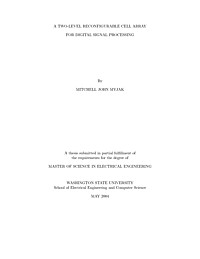
A Two-Level Reconfigurable Cell Array for Digital Signal Processing
Reconfigurable hardware has become an attractive option for implementing digital signal processing, especially in systems that require both high performance and flexibility. This thesis presents a novel two-level reconfigurable architecture targeted toward systems with these requirements. The architecture supports a large orthogonal design space whereby designers can customize the word length, amount of parallelism, number of functional units, and functional unit connectivity to meet the needs of the application. On the upper level, algorithms are mapped onto an array of 4-bit cells and a hierarchical interconnection fabric. The interconnection structure contains a mesh of 4-bit busses for local data transfer, as well as an H-tree for communicating results between functional units. On the lower level, each cell contains a small matrix of elements that collectively implement all necessary operations. The matrix of elements has only two configurations: one optimized for mathematical functions such as multiply-accumulates, and the other optimized for memory operations. The system also contains pipeline latches to maximize clock rate and throughput. Circuit simulations indicate that the architecture achieves a clock frequency of 200 MHz in a modest 0.25-μm CMOS technology. An initial prototype of the reconfigurable cell has been fabricated in 0.5-μm CMOS and tested for functionality. The estimated execution time for a 16-bit, 256-point Fast Fourier Transform shows a speedup ranging from 1.6 to 14 compared to contemporary digital signal processors.
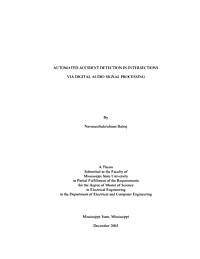
Automated Accident Detection in Intersections Via Digital Audio Signal Processing
The aim of this thesis is to design a system for automated accident detection in intersections. The input to the system is a three-second audio signal. The system can be operated in two modes: two-class and multi-class. The output of the two-class system is a label of “crash” or “non-crash”. In the multi-class system, the output is the label of “crash” or various non-crash incidents including “pile drive”, “brake”, and “normal-traffic” sounds. The system designed has three main steps in processing the input audio signal. They are: feature extraction, feature optimization and classification. Five different methods of feature extraction are investigated and compared; they are based on the discrete wavelet transform, fast Fourier transform, discrete cosine transform, real cepstrum transform and Mel frequency cepstral transform. Linear discriminant analysis (LDA) is used to optimize the features obtained in the feature extraction stage by linearly combining the features using different weights. Three types of statistical classifiers are investigated and compared: the nearest neighbor, nearest mean, and maximum likelihood methods. Data collected from Jackson, MS and Starkville, MS and the crash signals obtained from Texas Transportation Institute crash test facility are used to train and test the designed system. The results showed that the wavelet based feature extraction method with LDA and maximum likelihood classifier is the optimum design. This wavelet-based system is computationally inexpensive compared to other methods. The system produced classification accuracies of 95% to 100% when the input signal has a signal-to-noise-ratio of at least 0 decibels. These results show that the system is capable of effectively classifying “crash” or “non-crash” on a given input audio signal.
Efficient Signal Processing Techniques for Future Wireless Communications Systems
Wireless communications systems are evolving to be more diverse in use and more ubiquitous in nature. It is of fundamental importance that we consume the resources available in such systems, i.e., bandwidth and energy, to preserve room for more users and to preserve longevity. Signal processing can greatly help us achieve this. In this thesis we consider improving the utility of resources available in wireless communications systems. The basic obstacle for most wireless communications systems is the multipath channel that causes intersymbol interference. Channel estimation is a crucial step for recovering the transmitted symbols. Moreover, as more devices are equipped with wireless capabilities, the bandwidth becomes scarce and it is important to allow more than one device or more than one user to use the same frequency range or the same channel. However, this introduces multiuser interference, which is again eliminated only if the channel is known. Furthermore, most wireless systems are battery powered, at least at the transmitter end. Hence it is crucial that energy consumption is minimized to preserve the longevity of the system. The contribution of this thesis is three fold: (i) We propose novel bandwidth efficient blind channel estimation algorithms for single input multiple output systems, and for multiuser OFDM systems. The former exploits cyclostationarity inherent in communications signals. The latter exploits the structure introduced to the transmitted signal via precoding. We consider design of such precoders by optimizing performance metrics such as the bit error rate and signal to interference plus noise ratio. (ii) In the multiuser systems case, we propose a novel cooperative OFDM system and show that, when users face significantly different channel conditions, cooperation can improve the performance of all the cooperating users. (iii) We consider energy efficient training based system estimation in large MIMO systems. The goal there is to minimize energy consumption both in transmission of training symbols and in performing computations. We show that by using a divide and conquer strategy in selecting the active set of transmitters and receivers, it is possible to minimize energy consumption without degrading the accuracy of the channel estimate.
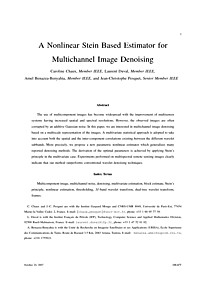
A Nonlinear Stein Based Estimator for Multichannel Image Denoising
The use of multicomponent images has become widespread with the improvement of multisensor systems having increased spatial and spectral resolutions. However, the observed images are often corrupted by an additive Gaussian noise. In this paper, we are interested in multichannel image denoising based on a multiscale representation of the images. A multivariate statistical approach is adopted to take into account both the spatial and the inter-component correlations existing between the different wavelet subbands. More precisely, we propose a new parametric nonlinear estimator which generalizes many reported denoising methods. The derivation of the optimal parameters is achieved by applying Stein’s principle in the multivariate case. Experiments performed on multispectral remote sensing images clearly indicate that our method outperforms conventional wavelet denoising techniques.








